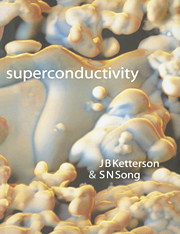Book contents
- Frontmatter
- Contents
- Preface
- Part I Phenomenologlcal theories of superconductivity
- 1 Introduction
- 2 The London–London equation
- 3 Pippard's equation
- 4 Thermodynamics of a Type I superconductor
- 5 The intermediate state
- 6 Surface energy between a normal and a superconducting metal
- 7 Quantized vorticity
- 8 Type II superconductivity
- 9 The Ginzburg–Landau theory
- 10 The upper critical field of a Type II superconductor
- 11 The anisotropic superconductor
- 12 Thin superconducting slabs
- 13 Surface superconductivity
- 14 The Type II superconductor for H just below Hc2
- 15 The Josephson effects
- 16 The Josephson lattice in ID
- 17 Vortex structure in layered superconductors
- 18 Granular superconductors: the Josephson lattice in 2D and 3D
- 19 Wave propagation in Josephson junctions, superlattices, and arrays
- 20 Flux pinning and flux motion
- 21 Time-dependent G–L theory
- 22 Fluctuation effects
- 23 G–L theory of an unconventional superfluid
- 24 Landau Fermi liquid theory
- Part II The microscopic theory of a uniform superconductor
- Part III Nonuniform superconductivity
- Appendix A Identical particles and spin: the occupation number representation
- Appendix B Some calculations involving the BCS wavefunction
- Appendix C The gap as a perturbation through third order
- Superconducting transition temperature, thermodynamic critical field, Debye temperature and specific heat coefficient for the elements
- References
- Additional reading
- List of mathematical and physical symbols
- Index
21 - Time-dependent G–L theory
Published online by Cambridge University Press: 05 June 2012
- Frontmatter
- Contents
- Preface
- Part I Phenomenologlcal theories of superconductivity
- 1 Introduction
- 2 The London–London equation
- 3 Pippard's equation
- 4 Thermodynamics of a Type I superconductor
- 5 The intermediate state
- 6 Surface energy between a normal and a superconducting metal
- 7 Quantized vorticity
- 8 Type II superconductivity
- 9 The Ginzburg–Landau theory
- 10 The upper critical field of a Type II superconductor
- 11 The anisotropic superconductor
- 12 Thin superconducting slabs
- 13 Surface superconductivity
- 14 The Type II superconductor for H just below Hc2
- 15 The Josephson effects
- 16 The Josephson lattice in ID
- 17 Vortex structure in layered superconductors
- 18 Granular superconductors: the Josephson lattice in 2D and 3D
- 19 Wave propagation in Josephson junctions, superlattices, and arrays
- 20 Flux pinning and flux motion
- 21 Time-dependent G–L theory
- 22 Fluctuation effects
- 23 G–L theory of an unconventional superfluid
- 24 Landau Fermi liquid theory
- Part II The microscopic theory of a uniform superconductor
- Part III Nonuniform superconductivity
- Appendix A Identical particles and spin: the occupation number representation
- Appendix B Some calculations involving the BCS wavefunction
- Appendix C The gap as a perturbation through third order
- Superconducting transition temperature, thermodynamic critical field, Debye temperature and specific heat coefficient for the elements
- References
- Additional reading
- List of mathematical and physical symbols
- Index
Summary
A system which is disturbed from its equilibrium state will relax toward equilibrium when the associated perturbation is removed. This relaxation process has two characteristic forms in general: (i) damped oscillations, or (ii) monotonic decay. In this section we will be concerned primarily with the latter type of decay (oscillatory responses of bulk superconductors will be discussed in Sec. 54 and are termed collective modes).
Thermodynamic systems have characteristic microscopic (rapid) relaxation times and the relaxation of the vast majority of their internal degrees of freedom proceeds on these time scales. There are two important exceptions: (i) modes involving degrees of freedom for which conservation laws exist; and (ii) additional modes involving a broken symmetry of the system. The conservation laws are those involving mass (or charge), energy (or entropy) and momentum (which, being a vector quantity, involves an equation for each component). For a liquid this leads to the existence of five low frequency (also called hydrodynamic) modes involving: a heat conduction mode (1), transverse viscous shear waves (2), and longitudinal sound (2). The number in parentheses denotes the number of such modes, there being five in all, corresponding to the five conservation laws. For a derivation of this mode structure see Landau and Lifshitz (1987) or Miyano and Ketterson (1979). Additional equations of motion exist when the system spontaneously breaks some symmetry, and we now list some examples.
- Type
- Chapter
- Information
- Superconductivity , pp. 140 - 143Publisher: Cambridge University PressPrint publication year: 1999



